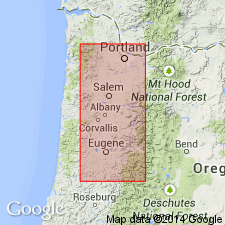
- Usage in publication:
-
- [Dallas Limestone Bed]
- Modifications:
-
- Original reference
- Dominant lithology:
-
- Limestone
- AAPG geologic province:
-
- Western Columbia basin
Summary:
Pg. 2-5. Dallas Limestone crops out as dark-gray massive rock, which weathers first to light-buff color and then to deeper shades of iron oxide. Thickness 50 to 75 feet. Occurs at base of marine series of Cowlitz age and above basalt believed to be equivalent of Tillamook volcanics. May occupy stratigraphic position similar to Buell limestone (new). Age is late Eocene.
Type locality not stated. Crops out in northeast part of T. 8 S., R. 6 W., from 2 to 4 mi southwest of Dallas, Polk Co., on western edge of Willamette Valley, western OR. Extensively quarried.
Source: US geologic names lexicon (USGS Bull. 1200, p. 1037).

- Usage in publication:
-
- Dallas Limestone Member
- Modifications:
-
- Revised
- AAPG geologic province:
-
- Western Columbia basin
Baldwin, E.M., 1959, Geology of Oregon: Ann Arbor, MI, Edwards Bros., Inc., __ p.
Summary:
Pg. 13. Dallas Limestone Member of Yamhill Formation. Present at base of formation. Composed of fragments of shells, Foraminifera, and calcareous algae intermixed with tuffaceous material derived from underlying volcanic rocks. Age is late Eocene.
Source: US geologic names lexicon (USGS Bull. 1200, p. 1037).
For more information, please contact Nancy Stamm, Geologic Names Committee Secretary.
Asterisk (*) indicates published by U.S. Geological Survey authors.
"No current usage" (†) implies that a name has been abandoned or has fallen into disuse. Former usage and, if known, replacement name given in parentheses ( ).
Slash (/) indicates name conflicts with nomenclatural guidelines (CSN, 1933; ACSN, 1961, 1970; NACSN, 1983, 2005, 2021). May be explained within brackets ([ ]).

